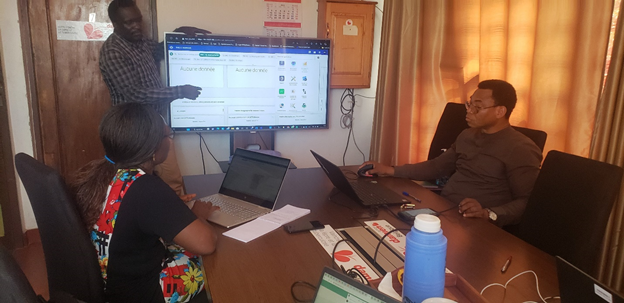General introduction
Burundi has a nationwide TB surveillance system. The system is based on aggregated monthly data, reported in paper format to the CDT and encoded in the DHIS2. Of the 13 WHO standards for TB surveillance data quality, 12 are applicable. Of these, four (4) are met, two (2) are partially met, six (6) are not met and one (1) is not applicable. Strengths include a clear flow of surveillance data, implementation of case definitions, 100% completeness rate, parameterization of DHIS2 tracker for sensitive TB and TBMR. Areas for improvement include under-detection of TB in general and in children in particular, poor TB screening in diabetics, systematic TB screening in PLHIV, the system for collecting and transporting samples and the maintenance of GeneXpert equipment. Particular challenges for the PNILT are the collection of sensitive TB and TBMR data in the DHIS2 tracker in all CDTs.
Pre-digitization data quality challenges for the tuberculosis survey
In response to the challenges posed by TB drug resistance in Burundi, the Ministry of Public Health and AIDS Control (MSPLS) sought to improve data management and better understand TB drug resistance trends.
To this end, the Ministry of Health has integrated the TB Drug Resistance Survey (TB-DRS) module into DHIS2, a data collection tool specialized in conducting surveys on tuberculosis drug resistance.
These surveys investigate drug resistance in a representative sample of the TB-affected population, providing information for the development of targeted control strategies. Previously, TB data had been collected using paper forms and MS Excel, leading to data quality problems and delays in reporting. The main objective of this technical assistance was to finalize the TB-DRS package in DHIS2 for the Burundi DRS-TB survey, in order to streamline collection and improve data quality for a more comprehensive understanding of TB drug resistance.

Contact meeting between the HISP Rwanda team and the MSPLS TB Program
Digitizing the tuberculosis drug resistance survey to improve data quality, knowledge and efficiency
The HISP Rwanda consultancy team collaborated with the Burundi tuberculosis program and Action Damien (a Belgian NGO) to revise and harmonize all tuberculosis and anti-tuberculosis drug resistance monitoring data, ensuring that they were perfectly aligned with the distributed survey questionnaire.
The survey form was meticulously customized to meet the specific needs of the Burundi TB drug resistance survey.
This was followed by the configuration of metadata for the TB-DRS module, including the revision of data attributes, the establishment of validation rules and the creation of customized program indicators and dashboards. The Direction nationale du système d’information sanitaire (DSNIS) provided a server for the project, and the HISP Rwanda team configured three instances on the server (development, training and production).
Comprehensive user manuals, including a system technical document and a user guide, have been developed to facilitate the effective use of the DHIS2- DRS module by users. The team organized a 5-day training program to ensure effective use of the TB-DRS module. The first two days were devoted to data entry steps using DHIS2 monitoring software for the DRS module, while the remaining days were devoted to data analysis training for analytical team members. The data entry operators then began to enter actual data in the production environment.
Throughout the implementation process, several difficulties were encountered, including two-stage data entry (clinical data first, laboratory data second) and incomplete survey forms, particularly in the laboratory section. To resolve these problems, the data entry team, under the supervision of the principal investigator, has
carried out field visits to gather the missing information needed for accurate and reliable data analysis.

TB-DRS System presentation to principal investigators
Support effective decision-making with DHIS2-based analysis and visualization.
The successful integration of the TB-DRS module into DHIS2 has significantly improved tuberculosis data management in Burundi. By streamlining data collection and improving data quality, Burundi now has crucial information on trends in TB drug resistance. This information facilitates informed decision- making and the development of targeted strategies to reduce TB incidence and mortality rates. The implementation of the digital solution marks an important step in strengthening Burundi’s efforts to combat TB drug resistance and improve TB control measures. Continued technical assistance and active participation in results analysis will further improve the use and interpretation of data, leading to improved TB control outcomes.
Dashboard design (data is not real)
